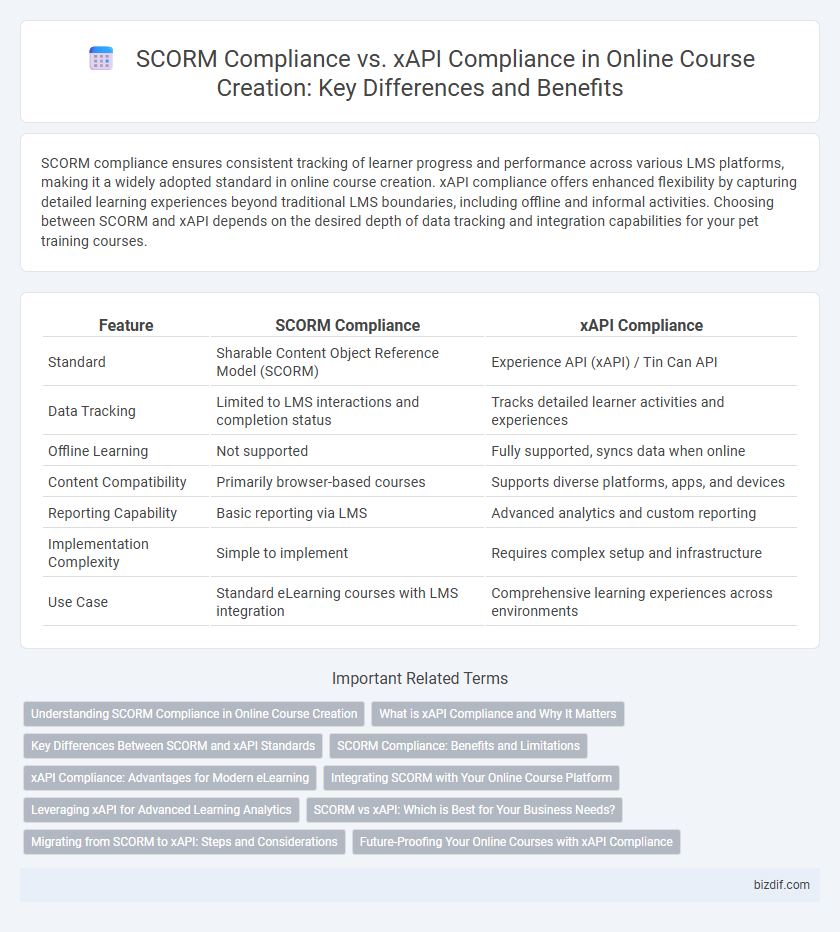SCORM compliance ensures consistent tracking of learner progress and performance across various LMS platforms, making it a widely adopted standard in online course creation. xAPI compliance offers enhanced flexibility by capturing detailed learning experiences beyond traditional LMS boundaries, including offline and informal activities. Choosing between SCORM and xAPI depends on the desired depth of data tracking and integration capabilities for your pet training courses.
Table of Comparison
| Feature | SCORM Compliance | xAPI Compliance |
|---|---|---|
| Standard | Sharable Content Object Reference Model (SCORM) | Experience API (xAPI) / Tin Can API |
| Data Tracking | Limited to LMS interactions and completion status | Tracks detailed learner activities and experiences |
| Offline Learning | Not supported | Fully supported, syncs data when online |
| Content Compatibility | Primarily browser-based courses | Supports diverse platforms, apps, and devices |
| Reporting Capability | Basic reporting via LMS | Advanced analytics and custom reporting |
| Implementation Complexity | Simple to implement | Requires complex setup and infrastructure |
| Use Case | Standard eLearning courses with LMS integration | Comprehensive learning experiences across environments |
Understanding SCORM Compliance in Online Course Creation
SCORM compliance in online course creation ensures interoperability, allowing courses to function seamlessly across various Learning Management Systems (LMS). It standardizes content packaging, sequencing, and tracking, enabling consistent learner progress monitoring. While SCORM focuses on traditional e-learning data, understanding its limitations is essential when evaluating newer standards like xAPI for more detailed learning analytics.
What is xAPI Compliance and Why It Matters
xAPI compliance refers to the ability of an e-learning system to track and record detailed learner interactions across multiple platforms, providing granular data beyond traditional SCORM limitations. Unlike SCORM, xAPI enables the capture of learning experiences both online and offline, offering comprehensive insights into learner performance and behaviors. This advanced tracking capability enhances personalized learning paths, real-time analytics, and improved training effectiveness in online course creation.
Key Differences Between SCORM and xAPI Standards
SCORM compliance primarily tracks learner interactions within a Learning Management System (LMS), capturing limited data such as course completion, time spent, and test scores. xAPI compliance expands this capability by enabling tracking of diverse learning experiences across various platforms, including mobile apps, simulations, and real-world activities, with detailed activity records stored in a Learning Record Store (LRS). The key differences lie in data scope, flexibility, and interoperability, where SCORM is LMS-centric and xAPI offers enhanced data granularity and cross-platform learning analytics.
SCORM Compliance: Benefits and Limitations
SCORM compliance ensures standardized content packaging and seamless integration with most Learning Management Systems (LMS), enhancing interoperability and tracking learner progress efficiently. It supports reliable reporting on course completion, time spent, and pass/fail status, making it ideal for traditional e-learning environments. However, SCORM's limitations include restricted tracking capabilities beyond basic interactions and a lack of support for complex learning experiences or offline activity monitoring compared to more advanced standards like xAPI.
xAPI Compliance: Advantages for Modern eLearning
xAPI compliance offers advanced tracking capabilities beyond SCORM by capturing detailed learner interactions across multiple platforms and devices, enabling robust data collection for personalized learning experiences. Its flexibility supports offline learning and integrates seamlessly with modern Learning Record Stores (LRS), providing comprehensive analytics for performance improvement. xAPI's ability to track informal and experiential learning makes it a superior choice for adaptive, modern eLearning environments.
Integrating SCORM with Your Online Course Platform
Integrating SCORM with your online course platform ensures standardized tracking of learner progress and completion across diverse LMS environments, enhancing compatibility and interoperability. SCORM compliance supports detailed reporting on course activities through established protocols, while xAPI compliance extends tracking capabilities by capturing rich, experiential learning data beyond the LMS. Selecting SCORM integration provides a reliable baseline for course standards adherence, facilitating consistent content delivery and assessment within most e-learning systems.
Leveraging xAPI for Advanced Learning Analytics
xAPI compliance offers advanced learning analytics capabilities far beyond SCORM by tracking a broader range of learning experiences across multiple platforms and devices. It captures detailed data on learner interactions, enabling educators to analyze performance patterns, skill development, and engagement in real-time. Leveraging xAPI allows for more personalized and effective online course creation through rich data insights and cross-environment interoperability.
SCORM vs xAPI: Which is Best for Your Business Needs?
SCORM compliance ensures standardized content packaging and tracking within traditional Learning Management Systems (LMS), making it ideal for businesses requiring basic interoperability and compatibility. xAPI compliance offers advanced data collection, tracking diverse learning experiences both online and offline, providing deeper insights into learner behavior and performance. Choosing between SCORM and xAPI depends on whether your business prioritizes straightforward LMS integration or comprehensive analytics for personalized learning paths.
Migrating from SCORM to xAPI: Steps and Considerations
Migrating from SCORM to xAPI requires evaluating your current e-learning platform's compatibility and updating course content to capture detailed learner interactions beyond traditional tracking. Develop or integrate an xAPI Learning Record Store (LRS) to collect and analyze comprehensive data on learner performance and behaviors in diverse environments. Ensure compliance testing to validate data accuracy and interoperability, while considering security protocols and reporting capabilities specific to xAPI standards.
Future-Proofing Your Online Courses with xAPI Compliance
xAPI compliance offers robust tracking capabilities beyond traditional SCORM limitations, enabling detailed learner behavior data across multiple platforms and devices. This future-proof standard supports emerging technologies like VR and mobile learning, ensuring your online courses remain relevant and adaptable. Adopting xAPI compliance future-proofs course delivery by facilitating comprehensive analytics and seamless integration with evolving e-learning ecosystems.
SCORM compliance vs xAPI compliance Infographic

 bizdif.com
bizdif.com